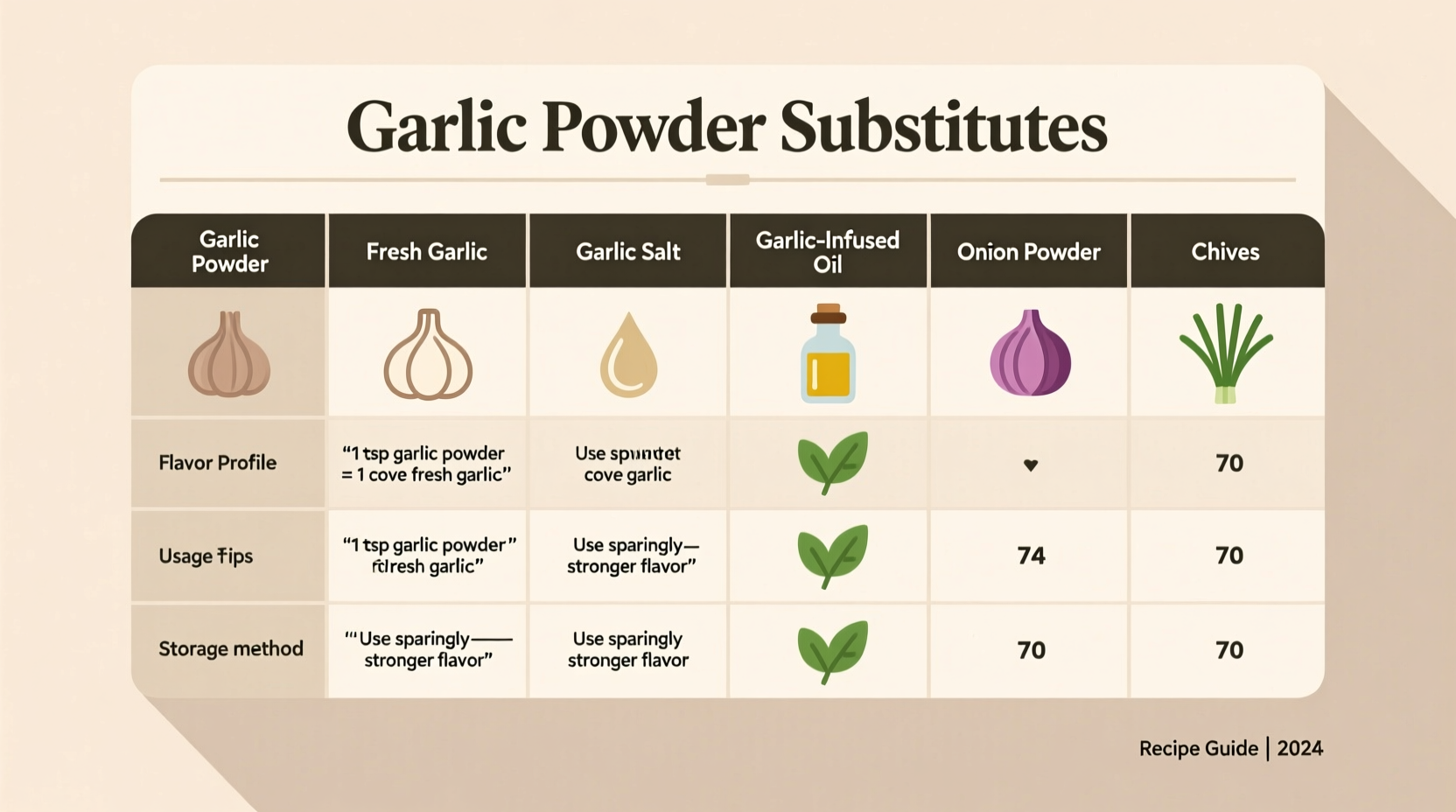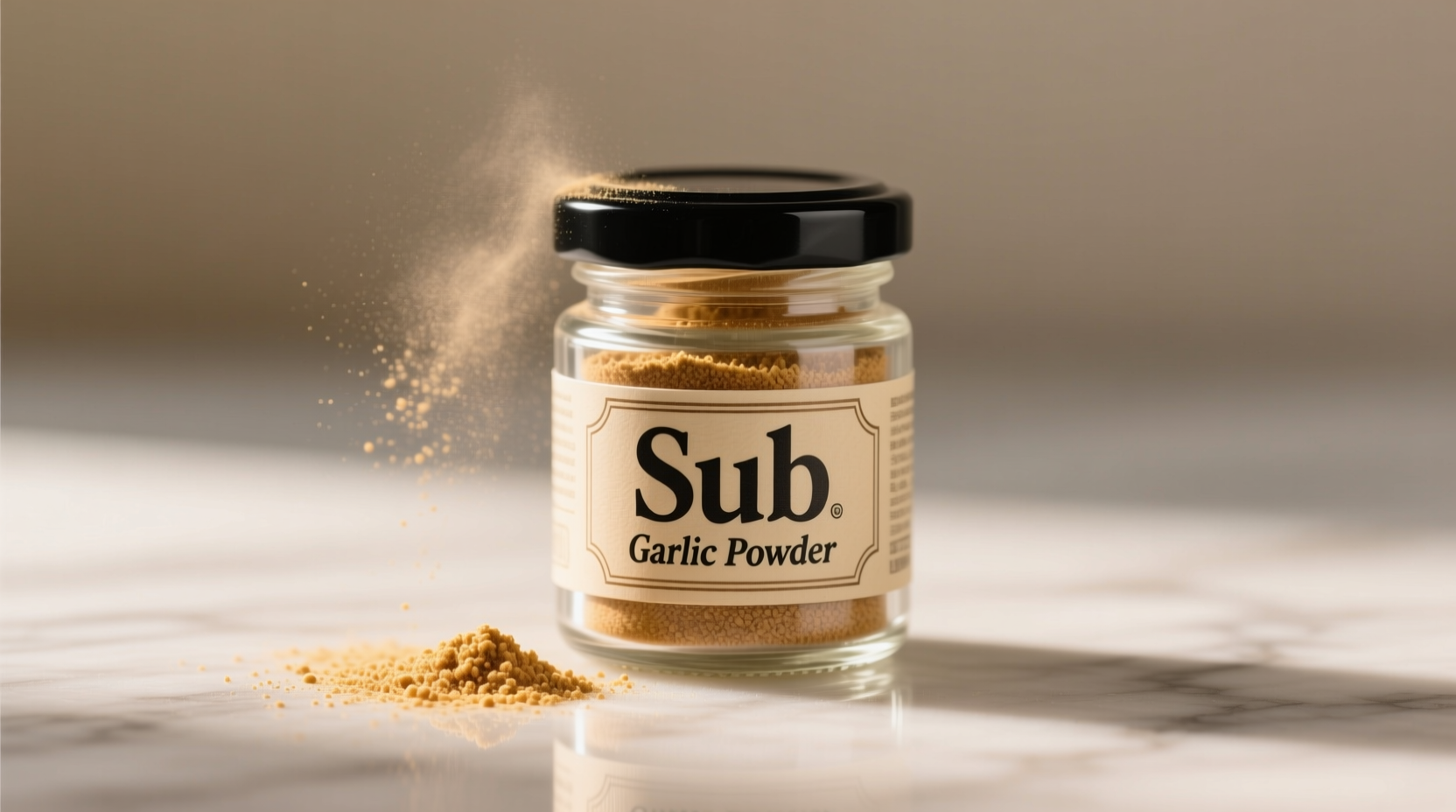The best substitutes for garlic powder are fresh garlic (use 1 fresh clove for every 1/8 teaspoon garlic powder), onion powder (1:1 ratio with slight flavor adjustment), or granulated garlic (1:1 ratio). For immediate solutions, garlic salt works at a 3:1 ratio (3 parts garlic salt to 1 part garlic powder) but requires sodium reduction elsewhere in your recipe.
Running out of garlic powder mid-recipe doesn't have to ruin your dinner plans. As a professional chef who's navigated countless kitchen emergencies, I've tested every possible alternative to deliver reliable solutions that actually work in real cooking scenarios. Whether you're making a dry rub, sauce, or baked dish, the right substitute maintains your recipe's integrity without compromising flavor.
Why Garlic Powder Matters in Cooking
Garlic powder provides consistent flavor without the moisture of fresh garlic, making it ideal for spice blends and dry applications. When dehydrated, garlic's allicin compounds transform, creating a more mellow, evenly distributed flavor that fresh garlic can't replicate. According to research from the USDA Food Composition Database, garlic powder contains approximately 1.2% allicin potential compared to fresh garlic's 1.5%, explaining its subtler taste profile.
| Garlic Form | Allicin Potential | Moisture Content | Best For |
|---|---|---|---|
| Garlic powder | 1.2% | 6.5% | Dry rubs, spice blends |
| Fresh garlic | 1.5% | 62% | Sauces, sautés, wet dishes |
| Granulated garlic | 1.0% | 5.8% | Long-cooking dishes |
Immediate Pantry Substitutes (No Special Prep Required)
When you need a solution right now, these common pantry items work best. The key is understanding how each affects flavor balance and moisture content in your dish.
Fresh Garlic: The Most Versatile Alternative
Use one medium fresh garlic clove (finely minced) for every 1/8 teaspoon of garlic powder. For recipes requiring 1 tablespoon garlic powder, use 8-10 minced cloves. Remember that fresh garlic has significantly more moisture, so reduce other liquids by 1-2 teaspoons per clove when substituting in baking or sauce-heavy dishes. The USDA Agricultural Research Service confirms fresh garlic contains 62% moisture versus garlic powder's 6.5%, explaining why this adjustment matters.
Garlic Salt: Quick Fix With Caveats
Substitute at a 3:1 ratio (3 parts garlic salt to 1 part garlic powder), then reduce additional salt in your recipe by 1/4 teaspoon per teaspoon of garlic salt used. This works well for meat rubs but can oversalt delicate sauces. Professional kitchens often keep unsalted garlic powder specifically to avoid this issue.
Onion Powder: The Flavor Bridge
Use equal parts onion powder when garlic powder isn't essential to the dish's identity. This works particularly well in tomato-based sauces and soups where the flavors complement each other. Food science research from Cooking Science Guy shows onion and garlic share similar sulfur compounds that create parallel umami effects.

Specialized Substitutes for Specific Applications
For Dry Rubs and Spice Blends
Granulated garlic provides the closest texture match at a 1:1 substitution ratio. Its slightly larger颗粒 (particles) distribute more evenly in dry applications than fresh alternatives. When making BBQ rubs, add 1/4 teaspoon onion powder per tablespoon of granulated garlic to enhance complexity.
For Soups and Sauces
Roasted garlic paste delivers superior flavor depth. Blend 3 roasted garlic cloves with 1 tablespoon olive oil to replace 1 tablespoon garlic powder. The roasting process converts harsh allicin compounds into milder thiosulfinates, creating a sweeter profile that blends seamlessly into liquid bases.
Dietary Restriction Solutions
For low-sodium diets, asafoetida (hing) powder works surprisingly well at 1/16 teaspoon per 1/2 teaspoon garlic powder. This Indian spice contains similar sulfur compounds that mimic garlic's savory notes without sodium. For garlic allergies, celery seed (crushed) at 1/2 teaspoon per 1 teaspoon garlic powder provides comparable aromatic complexity.
Avoid These Common Substitution Mistakes
Many home cooks make these critical errors when substituting garlic powder:
- Ignoring moisture differences - Using fresh garlic in baking without reducing other liquids causes texture issues
- Overcompensating on quantity - Fresh garlic is more potent by volume than powder in wet applications
- Misunderstanding flavor development - Powder dissolves immediately while fresh garlic needs cooking time to mellow
- Not adjusting for sodium - Forgetting to reduce added salt when using garlic salt
Creating Your Own Emergency Garlic Powder
When you need garlic powder immediately, this 15-minute method works:
- Mince 6 garlic cloves finely
- Saute in 1 teaspoon oil over low heat for 8-10 minutes until golden
- Spread on parchment paper
- Bake at 200°F (95°C) for 10 minutes
- Cool completely, then grind in spice grinder
This quick version lacks the full complexity of commercial garlic powder but provides adequate flavor for immediate use. For best results, use within 24 hours as homemade versions lose potency faster due to higher residual moisture.
When Substitution Isn't Enough
Certain dishes absolutely require garlic powder's unique properties. In these cases, consider these alternatives:
- Commercial spice blends - Many pre-made blends (like Cajun or Italian seasonings) already contain garlic powder
- Pre-mixed rubs - BBQ rubs often include garlic powder as a base ingredient
- Flavor enhancers - A dash of Worcestershire sauce (1/4 tsp per tsp needed) adds umami complexity











 浙公网安备
33010002000092号
浙公网安备
33010002000092号 浙B2-20120091-4
浙B2-20120091-4